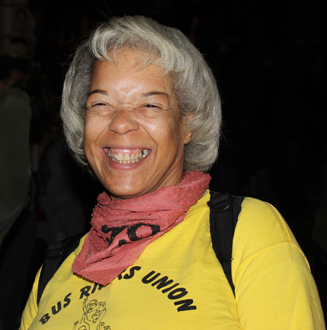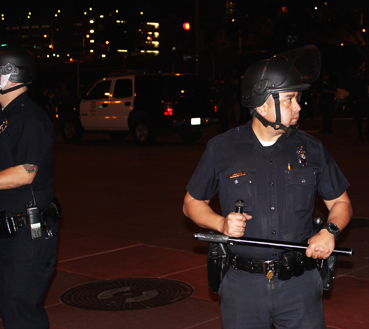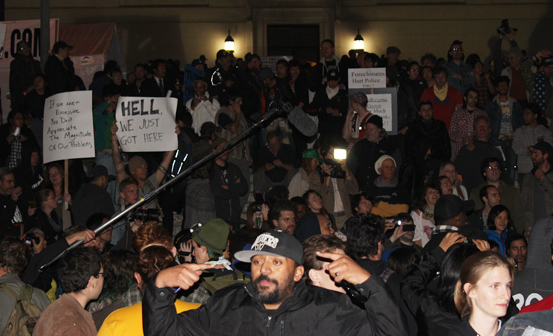
Inspired by the Occupy Wall Street movement in New York City, Occupy LA began on October 1st with a massive rally in the downtown of the city. For two months activists camped on the lawns of City Hall, drawing attention to corporate influence on politics and social and economic injustice, among other issues. Participants came from across the city and from a variety of backgrounds. By the end, thousands of protesters – including labor unions, religious clergy, students, political parties and activists – joined the movement.
In the beginning, Occupy Los Angeles received a warm welcome. City Council president Eric Garcetti invited protesters to, “stay as long as [they] need to.”
That all changed by late November when Mayor Antonio Villaraigosa ordered the park closed and the protesters removed. A few hours before the 12:01 AM Monday, November 28th deadline, thousands converged on City Hall in a show of solidarity that left the LAPD understaffed and unprepared to enforce the eviction. The mood that night was jubilant.
“I’m 51 years old and have never been arrested,” said a smiling Jodi Redman, as a police units arrived at City Hall. “But I’m unemployed and I have nothing to lose.”
A member of the Bus Riders’ Union, a labor organization committed to social, economic and environmental justice, Ms. Redman said she and her fellow unionists came to the final night of Occupy Los Angeles in solidarity.
She added: “We’re bus riders. We are the 99%.”
After the deadline passed, and the eviction remained un-enforced, about one thousand protesters took over an entire city block. A bus pulled up and led demonstrators into the street as Marvin Gaye’s ‘What’s Going On’ blasted from its speakers. Police responded to the street takeover, containing it to one block before eventually ordering them back into the park. Four people who refused to comply were arrested.
Wanting to avoid a repeat of the police violence that ended the Occupy Wall Street protests in Oakland and New York, LAPD Chief Charlie Beck ordered a more restrained approach. The LAPD, he said, can, “do it effectively and efficiently and with minimal force.”

Upon instructing demonstrators to vacate the park, police allowed protesters to leave voluntarily. Authorities then arrested nearly 300 engaged in civil disobedience.
In a press conference early that morning, Mayor Antonio Villaraigosa commended the police.”I said that here in L.A. we’d chart a different path, and we did,” Villaraigosa said.
Yet despite the mayor and police chief’s insistence that minimal force was used in the raid, reports have surfaced of beatings, street chases and of being held for days without charges.
Occupy LA activist Arpan Roy, 28, said he and group of protesters broke through a police barricade in an attempt to rejoin the main encampment, only to find another police line between them and the plaza. The crowd swelled and police ordered them to leave.
“Then the police, all in riot gear, rushed us with their batons out,” Mr. Roy explained. “They were chasing everyone out of downtown…I saw one guy get beaten earlier, too.”
A video surfaced of five policemen tackling a photographer to the ground. He, like many arrested protesters, sat in jail for days.
Yasha Levine, editor of the news site The eXiled, published an account of his arrest following the police raid.
“The 100 protesters in my detainee group were kept handcuffed with their hands behind their backs for 7 hours, denied food and water and forced to sit/sleep on a concrete floor,” Mr. Levine wrote. “Some were so tired they passed out face down on the cold and dirty concrete, hands tied behind their back.”
The under-reported police violence was in part a result of the ‘media-pool’ ordered by LAPD. Only 12 mainstream media outlets were allowed in as the police began arresting people. LAPD warned that other journalists found on the other side of police lines, like protesters, would be subject to arrest.

Yet Occupy LA activists insist that this is only the beginning.
“The encampments were vital and might be so again in the future,” added Mr. Roy, who when not participating at Occupy LA, operates Wild Los Angeles, a wilderness tour guide. “This is just the closing of the first stage of the Occupy movement.”
Indeed, actions by Occupy Los Angeles continue. A post-raid rally at Pershing Square in downtown LA occurred the following afternoon. Despite a heavy police presence, Occupy LA’s General Assembly continues to meet every night at City Hall. And on December 12th, as part of a coordinated West Coast effort, Occupy LA together with the Longshoremen’s Union will march on the Port of Los Angeles.
Yet beyond rallies, marches and encampments, Occupy LA’s most enduring impact has been on the individuals involved in the movement. No matter where someone’s politics fell before Occupy LA, the encampment often had the effect of radicalizing its participants.
Before she started going to Occupy LA, actress Tara Verrette, 24, wasn’t politically active.
“I knew nothing about what was going on in the U.S.,” she said. Then she visited Occupy LA and found herself protesting economic injustice and, “doing everything I can to help with getting the message to the media.”
Likewise, Arpan Roy, the wilderness guide, had been involved in progressive politics for years. But after his experience at Occupy LA, he found his politics were more radical than ever.
“I no longer believe in reforming this system,” he explained. “I think we need an entirely new one.”
For others, like 38-year-old visual artist Rob Ray, Occupy Los Angeles heightened their awareness.
“I always considered myself leftwing, but was not necessarily engaged,” said Mr. Ray in a telephone interview. After participating in Occupy LA, “I’m a changed person. I’ve become activated as someone who’s trying to think about the work they do and how it relates to economic instability and political injustice.”
California State University, Northridge student, Jason Born, discovered that the entire Occupy Wall Street movement “woke him up.”
“When I see an 84-year-old woman getting pepper sprayed, I’m going to do something about it,” Mr. Born said, referring to iconic image of Dorli Rainey soaked in pepper spray and milk at an Occupy Seattle protest.
On the final night of Occupy Los Angeles, 24-year-old Mr. Born came prepared to act as an informal medic. With the police closing in around the encampment, Mr. Born gestured to his backpack and said: “I have water, vinegar and am ready to give myself for the better.”
Sammy Loren is a writer and filmmaker based in Los Angeles. For more info visit his website: www.sammyloren.com
